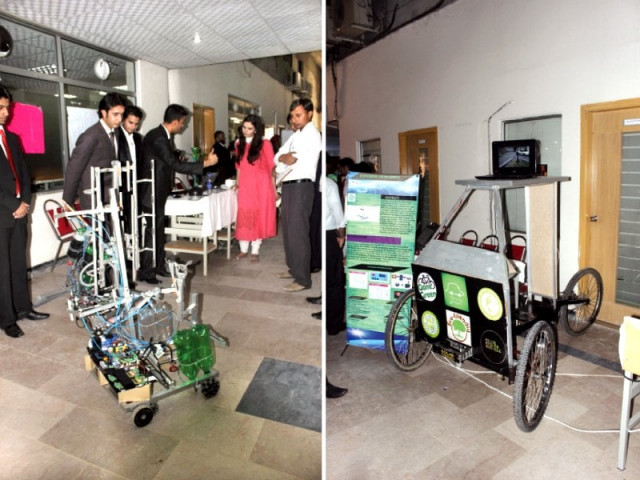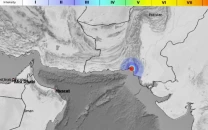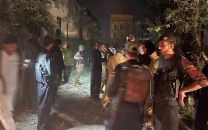Engineers of tomorrow: Innovative solutions to real-world problems
Thirty-five student projects including an online voting system, flood warning mechanism showcased.

The students showed awareness of the current political, socioeconomic and environmental challenges facing the county. PHOTO: WAQAS NAEEM/EXPRESS
With a problem-solving approach and a host of enterprising ideas, the engineers of tomorrow are gearing up to resolve the difficulties faced by Pakistan today.
The Centre for Advanced Studies in Engineering (CASE) held an open house at the Sir Syed Memorial Hall in the capital on Wednesday for the graduating class of 2013 where 35 projects, completed by the final-year undergraduate engineering students, were put on display.
From solar-powered solutions for home-based applications to an online voting system and a flood warning mechanism, the students showed awareness of the current political, socioeconomic and environmental challenges facing the country.

Bilal Nadeem, Bilal Feroz, Ameer Hamza and Muhammad Ibada used Direct Current (DC) power derived from a solar panel to run a Lahori air cooler and LED lights for their final-year project.
Hamza said they had changed the circuitry of the cooler’s pump and fan so it could be run on DC rather than Alternating Current (AC) from the mains. Usually, inverters are used to run AC devices on DC but Hamza and his team designed electronics circuitry so that the cooler could run directly on DC. The self-financed project had cost them around Rs30,000, said Hamza.
The group had also equipped the solar panel with the functionality to track the movement of the sun, using Light Dependent Resistors.
While Hamza’s group focused on renewable energy, Warda Ali and Sammana Batool looked at natural disaster preparedness for a calamity that has troubled Pakistan each year since 2010. The two undergraduates developed algorithms for an elevation-based flood warning system.
“We wanted to analyse those vulnerable areas in Pakistan which are at risk of flooding on a regular basis,” said Ali.
She said that their warning system relies on data from the Digital Elevation Model, which measures terrain elevations through satellite imaging, and from sensors deployed on the river banks at flood-prone sites.
The data are then analysed by algorithms to determine the height and width of a river or channel. A warning is generated whenever the water reaches a certain height defined in the algorithm, said Ali.
Other projects displayed at the open house included a biometric electronic voting system, smart power meters and a three-wheel solar-powered vehicle that could run for 1.5 hours at a speed of 40 kilometres per hour if an 80-watt solar panel on the vehicle’s roof was charged for three hours.
Pakistan’s representation on the international level was not missing, either.
A four-member group of electrical engineering students, led by Zafeerul Hassan, said they would be representing Pakistan at the 2013 Asia-Pacific Robot Contest (ABU Robocon) in Vietnam in August to showcase their robotics project.
Hassan said the CASE Robotics Group had been participating in ABU Robocon since 2010 and this year, his group had improved their robot design by incorporating pneumatics — a mechanical motion produced through compressed air — instead of inefficient motors.
Hassan said the group had designed two robots, one manual and one automatic, over a period of seven to eight months.
He said that the automatic robot is required to perform some tasks in the international contest such as throwing a projectile to hit a 30cm target and moving boxes from one location to another.
CASE is affiliated with the University of Taxila and offers courses in engineering and business administration.
Published in The Express Tribune, June 13th, 2013.



















COMMENTS
Comments are moderated and generally will be posted if they are on-topic and not abusive.
For more information, please see our Comments FAQ